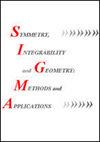张量与代数:张量模型的代数时空解释
IF 1
3区 物理与天体物理
Q2 MATHEMATICS
Symmetry Integrability and Geometry-Methods and Applications
Pub Date : 2023-10-18
DOI:10.3842/sigma.2023.076
引用次数: 3
摘要
寻找量子引力的一致理论是理论高能物理学中最具挑战性的问题之一。一种常用的方法是用度规张量或相关变量来描述引力自由度,并找到一种量化的方法。在正则张量模型中,重力自由度被编码为张量$P_{abc}$,随后这个量被量子化。这使得量子化在数学上更加直接,但是将这个张量作为时空的解释却不那么明显。在这项工作中,我们向完全理解与时空的关系迈出了第一步。通过考虑$P_{abc}$作为一个函数代数的生成器,我们首先描述了如何恢复紧致黎曼流形的拓扑和测度。使用张量秩分解,我们然后推广这个原理,以便有一个定义良好的拓扑和几何概念,对于一个大的类张量$P_{abc}$。我们提供了精确黎曼流形和摄动黎曼流形的拓扑和度量的出现,以及称为半局部圆的纯代数定义空间的一些例子。本文章由计算机程序翻译,如有差异,请以英文原文为准。
Tensors and Algebras: An Algebraic Spacetime Interpretation for Tensor Models
The quest for a consistent theory for quantum gravity is one of the most challenging problems in theoretical high-energy physics. An often-used approach is to describe the gravitational degrees of freedom by the metric tensor or related variables, and finding a way to quantise this. In the canonical tensor model, the gravitational degrees of freedom are encoded in a tensorial quantity $P_{abc}$, and this quantity is subsequently quantised. This makes the quantisation much more straightforward mathematically, but the interpretation of this tensor as a spacetime is less evident. In this work we take a first step towards fully understanding the relationship to spacetime. By considering $P_{abc}$ as the generator of an algebra of functions, we first describe how we can recover the topology and the measure of a compact Riemannian manifold. Using the tensor rank decomposition, we then generalise this principle in order to have a well-defined notion of the topology and geometry for a large class of tensors $P_{abc}$. We provide some examples of the emergence of a topology and measure of both exact and perturbed Riemannian manifolds, and of a purely algebraically-defined space called the semi-local circle.
求助全文
通过发布文献求助,成功后即可免费获取论文全文。
去求助
来源期刊
CiteScore
1.80
自引率
0.00%
发文量
87
审稿时长
4-8 weeks
期刊介绍:
Scope
Geometrical methods in mathematical physics
Lie theory and differential equations
Classical and quantum integrable systems
Algebraic methods in dynamical systems and chaos
Exactly and quasi-exactly solvable models
Lie groups and algebras, representation theory
Orthogonal polynomials and special functions
Integrable probability and stochastic processes
Quantum algebras, quantum groups and their representations
Symplectic, Poisson and noncommutative geometry
Algebraic geometry and its applications
Quantum field theories and string/gauge theories
Statistical physics and condensed matter physics
Quantum gravity and cosmology.

 求助内容:
求助内容: 应助结果提醒方式:
应助结果提醒方式:


